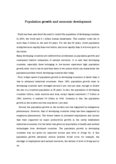連関資料 :: Population Growth
資料:2件
-
 Population growth and economic development
Population growth and economic development
- Much has been said about the need to control the population of developing countries. In 2000, the world had 6.1 billion human inhabitants. This number could rise to more than 9 billion in the next 50 years. For the last 50 years, world population multiplied more rapidly than ever before, and more rapidly than it will ever grow in the future. Many developing countries are suffered from acceleration in population growth and consequent relative exhaustion of natural resources. It is said that developing countries, especially those belonging to low-income experience high population growth rates. And it can be said that there is two points which can characterize the population problem which developing countries face today. First, today’s speed of population growth in developing economics is faster than it was in advanced industrial economies. Since 1950, population growth rates in developing countries have averaged around 2 per cent per year, enough to double the size of a countries population in 35 years. In fact, the population of developing countries (Africa, Latin America and Asia, except Japan) numbered 1.7 billion in 1950, however, it reached 3.6 billion in 1984. Contrary to this, the population growth in the modern era was only about 1 per year. Second, the population growth in the modern era was happened by endogenous phenomenon. However, that of developing countries today has been happened by exogenous phenomenon. The former based on increased employment and income that ware supported by major productivity growth in the newly established industrial economies, but the latter was given by importation of health and medical technologies from developed countries.
- レポート 国際関係学 英文レポート 人口増加 経済発達 資源
 550 販売中 2006/05/16
550 販売中 2006/05/16- 閲覧(1,470)


